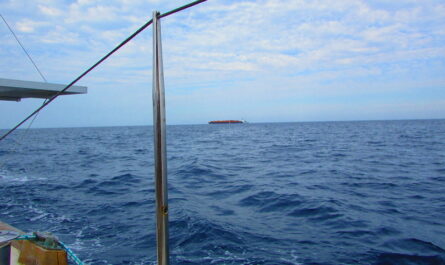The Atlantic Ocean, the world’s second-largest ocean, has long captivated the imagination of explorers, scientists, and oceanographers. From its role in global climate regulation to its rich biodiversity, the Atlantic has been a crucial part of human history and scientific discovery. However, much of the ocean, especially its depths, remains a mystery. Thanks to advancements in technology and renewed interest in deep-sea exploration, recent oceanographic research is shedding light on the hidden secrets of the Atlantic’s abyssal regions.
The Atlantic’s deep waters, often referred to as the abyss, lie thousands of meters below the surface. These dark, cold regions are home to a vast and largely unexplored ecosystem, filled with strange creatures, dramatic geological features, and complex oceanographic processes. In this article, we will explore the latest oceanographic research in the Atlantic, focusing on how scientists are venturing into the depths of the abyss to uncover new species, understand the ocean’s role in climate change, and reveal the geological wonders that lie beneath.
The Importance of Oceanographic Research in the Atlantic
Before diving into the depths of the Atlantic, it’s essential to understand why oceanographic research in this region is so critical. The Atlantic Ocean plays a pivotal role in regulating the Earth’s climate, particularly through its participation in the thermohaline circulation, or the “global conveyor belt,” which redistributes heat and nutrients around the globe. The ocean is also a reservoir of biodiversity, home to countless species, many of which remain undiscovered.
The deep-sea, or abyssal zone, which lies between 3,000 and 6,000 meters below the surface, is one of the least explored environments on Earth. It makes up the largest habitat on the planet but remains poorly understood due to its remoteness and the technical challenges of exploration. However, with the help of new technologies such as autonomous underwater vehicles (AUVs), remotely operated vehicles (ROVs), and advanced sensors, scientists are now able to explore these depths with unprecedented detail.
Recent research in the Atlantic is yielding insights that could not only change our understanding of marine ecosystems but also inform our response to global challenges like climate change and the sustainable use of ocean resources.
Discovering New Species in the Atlantic Abyss
One of the most exciting aspects of oceanographic research in the deep Atlantic is the discovery of new species. The deep ocean is home to a diverse range of life forms, many of which have evolved unique adaptations to survive in the extreme conditions of the abyss, where temperatures are just above freezing, and sunlight never penetrates.
Recent expeditions have uncovered numerous previously unknown species, adding to the ever-growing catalog of life in the deep Atlantic. For example, researchers have discovered new species of deep-sea corals, sponges, and fish living on the rocky outcrops and seamounts of the Atlantic abyss. These species thrive in nutrient-rich cold waters and often exhibit bioluminescence—a phenomenon in which organisms produce light through chemical reactions, allowing them to attract prey or communicate in the dark.
One particularly notable discovery is the Dumbo octopus, named for its ear-like fins that resemble the Disney character. These small, ghostly creatures live at depths of up to 4,000 meters and have captured the attention of scientists and the public alike. The Dumbo octopus is just one example of the extraordinary biodiversity found in the deep Atlantic, highlighting the potential for further discoveries as researchers continue to explore these remote regions.
Researchers are also discovering new hydrothermal vent ecosystems, where life thrives in the absence of sunlight. These deep-sea ecosystems are fueled by the heat and minerals emitted by underwater volcanic activity, creating unique conditions for life. At these vents, scientists have found species such as giant tube worms, vent shrimp, and chemoautotrophic bacteria that rely on chemical energy rather than sunlight for survival.
The Role of the Atlantic Abyss in Climate Regulation
Beyond its biological richness, the Atlantic abyss plays a critical role in regulating the Earth’s climate. The deep ocean is a major carbon sink, meaning it absorbs vast amounts of carbon dioxide (CO₂) from the atmosphere. This process helps to mitigate the effects of climate change by reducing the amount of CO₂ in the atmosphere. However, the mechanisms by which the deep ocean stores carbon and the factors that influence these processes are still not fully understood.
Recent oceanographic research in the Atlantic has focused on understanding the role of the abyss in the global carbon cycle. Scientists have been deploying specialized sensors and equipment to measure the flow of carbon into the deep ocean, as well as how long carbon remains stored in these deep waters. This research is crucial for predicting how the ocean’s ability to absorb carbon may change in the future as a result of climate change.
One of the key processes involved in carbon sequestration is the biological pump, in which marine organisms such as plankton absorb CO₂ during photosynthesis. When these organisms die, their carbon-rich remains sink to the ocean floor, where the carbon can be stored for centuries or even millennia. Understanding how the biological pump functions in the deep Atlantic is vital for assessing the ocean’s role in regulating the Earth’s climate.
Additionally, the Atlantic Ocean is a central component of the thermohaline circulation. This large-scale circulation pattern is driven by differences in temperature and salinity between water masses, which cause cold, dense water to sink in the North Atlantic and spread throughout the world’s oceans. This process plays a crucial role in regulating global climate by redistributing heat and influencing weather patterns.
Recent research suggests that the thermohaline circulation may be slowing down due to the melting of polar ice caps and the influx of freshwater into the North Atlantic. This could have profound consequences for global climate patterns, including more extreme weather events, disrupted ecosystems, and changes in sea level. Continued exploration of the deep Atlantic is essential for monitoring these changes and understanding their potential impacts.
Geological Discoveries: The Hidden Landscape of the Abyss
In addition to biological and climate research, the Atlantic abyss is a geological wonderland, home to dramatic features such as mid-ocean ridges, underwater mountains, deep-sea trenches, and hydrothermal vents. These geological formations provide valuable insights into the Earth’s history and the processes that shape the planet’s crust.
One of the most significant geological features of the Atlantic is the Mid-Atlantic Ridge, a massive underwater mountain range that runs down the center of the ocean, stretching for more than 10,000 miles from the Arctic Ocean to the Southern Ocean. The Mid-Atlantic Ridge is a divergent boundary, where tectonic plates are slowly moving apart, allowing magma from the Earth’s mantle to rise and form new oceanic crust. This process, known as seafloor spreading, is a key driver of plate tectonics and contributes to the formation of new landmasses over geological time.
Exploring the Mid-Atlantic Ridge and its surrounding areas has revealed a wealth of geological phenomena. For example, researchers have discovered hydrothermal vent fields along the ridge, where superheated water, rich in minerals, is expelled from the ocean floor. These vents create unique habitats for deep-sea organisms and offer clues about the conditions that may have supported the origin of life on Earth.
Scientists have also been studying the formation of seamounts, underwater mountains that rise from the ocean floor but do not reach the surface. These features are often hotspots of biodiversity, providing habitat for a wide range of marine species. Seamounts are also of interest for their potential role in deep-sea mining, as they are rich in minerals such as cobalt, nickel, and rare earth elements that are critical for modern technologies.
While deep-sea mining offers economic opportunities, it also poses significant environmental risks. The fragile ecosystems that exist on seamounts and hydrothermal vents could be severely impacted by mining activities, leading to the loss of biodiversity and the disruption of important ecological processes. Oceanographic research is helping to inform the debate over deep-sea mining by providing a better understanding of the potential environmental impacts and the need for sustainable management of ocean resources.
Technological Advances in Oceanographic Exploration
The exploration of the deep Atlantic would not be possible without recent technological advancements. In the past, the immense pressures and cold temperatures of the deep ocean made it nearly impossible to study these environments directly. However, the development of new tools and technologies is allowing scientists to explore the abyss with greater precision and at deeper depths than ever before.
One of the most significant advancements in deep-sea exploration is the use of autonomous underwater vehicles (AUVs) and remotely operated vehicles (ROVs). These robotic systems are equipped with high-resolution cameras, sonar, and sampling equipment, enabling them to operate in the extreme conditions of the deep ocean. AUVs and ROVs can explore areas that are too dangerous or difficult for human divers, providing detailed images and data from the ocean floor.
Another important tool in oceanographic research is the use of deep-sea submersibles. These manned vehicles allow scientists to descend into the abyss and observe marine life and geological features up close. The iconic Alvin submersible, operated by the Woods Hole Oceanographic Institution, has been instrumental in many deep-sea discoveries, including the first direct observations of hydrothermal vents in the Atlantic.
In addition to these vehicles, researchers are using a range of sensors and instruments to collect data on the physical and chemical properties of the deep ocean. These include CTD (conductivity, temperature, and depth) sensors, which measure salinity, temperature, and pressure, and oceanographic moorings, which are anchored to the seafloor and provide long-term monitoring of deep-sea conditions.
The Future of Oceanographic Research in the Atlantic
Oceanographic research in the Atlantic is entering an exciting new phase, driven by advances in technology, growing awareness of the ocean’s importance to global climate, and the need for sustainable management of marine resources. As scientists continue to explore the depths of the Atlantic abyss, they are likely to make even more groundbreaking discoveries about the ocean’s biodiversity, geological processes, and role in climate regulation.
One of the key challenges moving forward will be balancing the need for exploration and resource use with the protection of fragile deep-sea ecosystems. The deep Atlantic holds vast mineral and energy resources, but extracting these resources without causing irreversible harm to the environment will require careful planning and international cooperation.
At the same time, the data collected from oceanographic research will play a critical role in addressing global challenges such as climate change, ocean acidification, and biodiversity loss. By understanding how the deep ocean functions, scientists can make more accurate predictions about the future of our planet and develop strategies to mitigate the impacts of environmental change.
Conclusion
The latest oceanographic research in the Atlantic is uncovering the secrets of the abyss, revealing new species, unlocking the mysteries of the deep-sea carbon cycle, and shedding light on the geological forces that shape our planet. As technology continues to improve, scientists are able to explore deeper and with greater precision, offering new insights into one of the least understood environments on Earth.
The discoveries being made in the Atlantic’s abyssal regions are not only expanding our knowledge of the ocean but are also critical for addressing the pressing environmental challenges of our time. The deep Atlantic plays a crucial role in regulating the climate, supporting biodiversity, and providing resources for future generations. Protecting and understanding this vast, mysterious ecosystem is essential for the well-being of our planet and its inhabitants.



